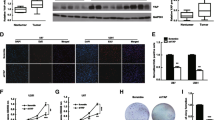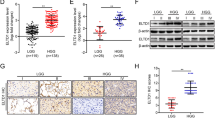Abstract
Although Wnt/β-catenin/Tcf signaling pathway has been shown to be a crucial factor in the development of many cancers, little is known about its role in glioma malignancy. In the present study, we report the first evidence that Wnt/β-catenin/Tcf signaling pathway is constitutively activated in experimental gliomas induced by single transplacental dose of N-ethyl-N-nitrosourea (ENU). In the present study we analyzed ENU induced rat gliomas of different stages (P90, P135 and P180) for the expression of β-catenin, Lef1, Tcf4 and their targets c-Myc, N-Myc and cyclin D1. Western blot analysis revealed upregulation of β-catenin, Lef1, Tcf4, c-Myc, N-Myc and cyclin D1 in gliomas compared to controls and their levels were progressively increased from initial stage (P90) to progression stage (P180). In consistent with this, immunohistochemistry revealed the cytoplasmic and nuclear accumulation of β-catenin, and nuclear positivity was evident for Lef1, Tcf4, c-Myc, N-Myc and cyclin D1. Based on these results, we conclude that Wnt/β-catenin pathway may play a major role in the tumorigenesis and tumor progression in ENU induced rat gliomas.







Similar content being viewed by others
References
Kleihues P, Cavenee WK (2000) Pathology and genetics of tumors of the central nervous system (World Health Organization Classification of Tumors), 2nd edn. Lyon, IARC
Kleihues P, Ohgaki H (1999) Primary and secondary glioblastomas: from concept to clinical diagnosis. Neuro Oncol 1:44–51. doi:10.1215/15228517-1-1-44
Holland EC (2001) Gliomagenesis: genetic alterations and mouse models. Nat Rev Genet 2:120–129. doi:10.1038/35052535
Simmons ML, Lamborn KR, Takahashi M et al (2001) Analysis of complex relationships between age, p53, epidermal growth factor receptor, and survival in glioblastoma patients. Cancer Res 61:1122–1128
Lacroix M, Abi-Said D, Fourney DR et al (2001) A multivariate analysis of 416 patients with glioblastoma multiforme: prognosis, extent of resection, and survival. J Neurosurg 95:190–198
Ohgaki H, Kleihues P (2007) Genetic pathways to primary and secondary glioblastoma. Am J Pathol 170:1445–1453. doi:10.2353/ajpath.2007.070011
Cavenee WK (1992) Accumulation of genetic defects during astrocytoma progression. Cancer 70(6 Suppl):1788–1793. doi:10.1002/1097-0142(19920915)70:4+<1788::AID-CNCR2820701621>3.0.CO;2-L
Louis DN (1997) A molecular genetic model of astrocytoma histopathology. Brain Pathol 7:755–764. doi:10.1111/j.1750-3639.1997.tb01062.x
Hayashi Y, Ueki K, Waha A et al (1997) Association of EGFR gene amplification and CDKN2 (p16/MTS1) gene deletion in glioblastoma multiforme. Brain Pathol 7:871–875. doi:10.1111/j.1750-3639.1997.tb00890.x
Moon RT, Brown JD, Torres M (1997) WNTs modulate cell fate and behavior during vertebrate development. Trends Genet 13:157–162. doi:10.1016/S0168-9525(97)01093-7
Cadigan KM, Nusse R (1997) Wnt signaling: a common theme in animal development. Genes Dev 11:3286–3305. doi:10.1101/gad.11.24.3286
Logan CY, Nusse R (2004) The Wnt signaling pathway in development and disease. Annu Rev Cell Dev Biol 20:781–810. doi:10.1146/annurev.cellbio.20.010403.113126
Moon RT, Kohn AD, De Ferrari GV et al (2004) WNT and beta-catenin signaling: diseases and therapies. Nat Rev Genet 5:691–701. doi:10.1038/nrg1427
Polakis P (1999) The oncogenic activation of beta-catenin. Curr Opin Genet Dev 9:15–21. doi:10.1016/S0959-437X(99)80003-3
Reya T, Clevers H (2005) Wnt signalling in stem cells and cancer. Nature 434:843–850. doi:10.1038/nature03319
Pinson KI, Brennan J, Monkley S et al (2000) An LDL-receptor-related protein mediates Wnt signalling in mice. Nature 407:535–538. doi:10.1038/35035124
Tamai K, Semenov M, Kato Y et al (2000) LDL-receptor-related proteins in Wnt signal transduction. Nature 407:530–535. doi:10.1038/35035117
Wehrli M, Dougan ST, Caldwell K et al (2000) Arrow encodes an LDL-receptor-related protein essential for wingless signalling. Nature 407:527–530. doi:10.1038/35035110
Brown JD, Moon RT (1998) Wnt signaling: why is everything so negative? Curr Opin Cell Biol 10:182–187. doi:10.1016/S0955-0674(98)80140-3
Wodarz A, Nusse R (1998) Mechanisms of Wnt signaling in development. Annu Rev Cell Dev Biol 14:59–88. doi:10.1146/annurev.cellbio.14.1.59
Cliffe A, Hamada F, Beinz M (2003) A role of dishevelled in relocating axin to the plasma membrane during wingless signaling. Curr Biol 13:960–966. doi:10.1016/S0960-9822(03)00370-1
He TC, Sparks AB, Rago C et al (1998) Identification of c-MYC as a target of the APC pathway. Science 281:1509–1512. doi:10.1126/science.281.5382.1509
Shiina H, Igawa M, Breault J et al (2003) The human T-cell factor-4 gene splicing isoforms, Wnt signal pathway and apoptosis in renal cell carcinoma. Clin Cancer Res 9:2121–2132
Shtutman M, Zhurinsky J, Simcha I et al (1999) The cyclin D1 gene is a target of the beta-catenin/LEF-1 pathway. Proc Natl Acad Sci USA 96:5522–5527. doi:10.1073/pnas.96.10.5522
Druckrey H, Ivankovic S, Preussmann R (1966) Teratogenic and carcinogenic effects in the offspring after a single injection of ethylnitrosourea to pregnant rats. Nature 210:1378–1379. doi:10.1038/2101378a0
Druckery H, Landschutz C, Ivankovic S (1970) Transplacental induction of malignant tumors of the central nervous system. II. ethylnitrosourea in 10 genetically defeined strains of rats. Z Krebsforsch 73:371–386. doi:10.1007/BF00524174
Shibuya T, Morimoto K (1993) A review of the genotoxicity of N-ethyl-N-nitrosourea. Mutat Res 297:3–38
Lantos PL (1986) Development of nitrosourea-induced brain tumours with a special note on changes occurring during latency. Food Chem Toxicol 24:121–127. doi:10.1016/0278-6915(86)90346-7
Swenberg JA, Koestner A, Wechsler W et al (1972) Quantitative aspects of transplacental tumor induction with ethylnitrosourea in rats. Cancer Res 32:2656–2660
Bilzer T, Reifenberger G, Wechsler W (1989) Chemical induction of brain tumors in rats by nitrosoureas: molecular biology and neuropathology. Neurotoxicol Teratol 11:551–556. doi:10.1016/0892-0362(89)90036-6
Slikker W 3rd, Mei N, Chen T (2004) N-ethyl-N-nitrosourea (ENU) increased brain mutations in prenatal and neonatal mice but not in the adults. Toxicol Sci 81:112–120. doi:10.1093/toxsci/kfh177
Bhaskara VK, Sundaram C, Babu PP (2006) pERK, pAkt and pBad: a possible role in cell proliferation and sustained cellular survival during tumorigenesis and tumor progression in ENU induced transplacental glioma rat model. Neurochem Res 31:1163–1170. doi:10.1007/s11064-006-9142-7
Kelleher FC, Fennelly D, Rafferty M (2006) Common critical pathways in embryogenesis and cancer. Acta Oncol 45:375–388. doi:10.1080/02841860600602946
Fogarty MP, Kessler JD, Wechsler-Reya RJ (2005) Morphing into cancer: the role of developmental signaling pathways in brain tumor formation. J Neurobiol 64:458–475. doi:10.1002/neu.20166
Morin PJ (1999) Beta-catenin signaling and cancer. Bioessays 21:1021–1030. doi:10.1002/(SICI)1521-1878(199912)22:1<1021::AID-BIES6>3.0.CO;2-P
Polakis P (2000) Wnt signaling and cancer. Genes Dev 14:1837–1851
Giles RH, van Es JH, Clevers H (2003) Caught up in a Wnt storm: Wnt signaling in cancer. Biochim Biophys Acta 1653:1–24
Yu JM, Jun ES, Jung JS et al (2007) Role of Wnt5a in the proliferation of human glioblastoma cells. Cancer Lett 257:172–181. doi:10.1016/j.canlet.2007.07.011
Howng SL, Wu CH, Cheng TS et al (2002) Differential expression of Wnt genes, beta-catenin and E-cadherin in human brain tumors. Cancer Lett 183:95–101. doi:10.1016/S0304-3835(02)00085-X
Zhang Z, Schittenhelm J, Guo K et al (2006) Upregulation of frizzled 9 in astrocytomas. Neuropathol Appl Neurobiol 32:615–624. doi:10.1111/j.1365-2990.2006.00770.x
Trosko JE (2001) Commnetary: in the concept of tumor formation, a useful paradigm? Mol Carcinog 30:131–137. doi:10.1002/mc.1021
Jang T, Savarese T, Low HP et al (2006) Osteopontin expression in intratumoral astrocytes marks tumor progression in gliomas induced by prenatal exposure to N-ethyl-N-nitrosourea. Am J Pathol 168:1676–1685. doi:10.2353/ajpath.2006.050400
Koestner A, Swenberg JA, Wechsler W (1971) Transplacental production with ethylnitrosourea of neoplasms of the nervous system in Sprague–Dawley rats. Am J Pathol 63:37–56
Schiffer D, Giordana MT, Mauro A et al (1980) Experimental brain tumors by transplacental ENU. Multifactorial study of the latency period. Acta Neuropathol 49:117–122. doi:10.1007/BF00690751
Jang T, Litofsky NS, Smith TW et al (2004) Aberrant nestin expression during ethylnitrosourea-(ENU)-induced neuro carcinogenesis. Neurobiol Dis 15:544–552. doi:10.1016/j.nbd.2003.11.016
Leonard JR, D’Sa C, Klocke BJ et al (2001) Neural precursor cell apoptosis and glial tumorigenesis following transplacental ethyl-nitrosourea exposure. Oncogene 20:8281–8286
Ilyas M, Tomlinson IP (1997) The interactions of APC, E-cadherin and beta-catenin in tumour development and progression. J Pathol 182:128–137. doi:10.1002/(SICI)1096-9896(199706)182:2<128::AID-PATH839>3.0.CO;2-Q
Aberle H, Bauer A, Stappert J et al (1997) Beta-catenin is a target for the ubiquitin-proteasome pathway. EMBO J 16:3797–3804. doi:10.1093/emboj/16.13.3797
Acknowledgments
Financial assistance of CSIR, ICMR, DBT, New Delhi, India and CSIR for fellowship to GRS is gratefully acknowledged.
Author information
Authors and Affiliations
Corresponding author
Rights and permissions
About this article
Cite this article
Sareddy, G.R., Challa, S., Panigrahi, M. et al. Wnt/β-catenin/Tcf Signaling Pathway Activation in Malignant Progression of Rat Gliomas Induced by Transplacental N-Ethyl-N-Nitrosourea Exposure. Neurochem Res 34, 1278–1288 (2009). https://doi.org/10.1007/s11064-008-9906-3
Accepted:
Published:
Issue Date:
DOI: https://doi.org/10.1007/s11064-008-9906-3




